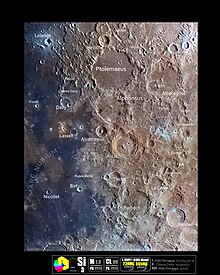Lassell is a small lunar impact crater that is located in the eastern part of the Mare Nubium. It was named after British astronomer William Lassell,[1] who discovered Uranian moons Ariel and Umbriel, among other achievements.

 Lunar Orbiter 4 image | |
| Coordinates | 15°30′S 7°54′W / 15.5°S 7.9°W |
|---|---|
| Diameter | 23 km |
| Depth | 0.9 km |
| Colongitude | 8° at sunrise |
| Eponym | William Lassell |
Lassell lies to the west of the crater Alpetragius and southwest of Alphonsus.



Description
editThe interior of Lassell has been flooded and resurfaced by lava, leaving a nearly flat surface with a low remaining outer rim. The surface has a low albedo, giving the interior a dark appearance. The surviving outer wall is generally circular but with a somewhat polygonal shape.
To the east-northeast is a circular, bowl-shaped crater designated Lassell B. This formation has a higher albedo than its surroundings and so appears relatively bright, especially at high sun angles.
The tiny crater Lassell D is located to the west-northwest of Lassell, about halfway to the ruined crater Guericke. This craterlet is surrounded by a patch of high-albedo surface, and is an example of a prominent lunar bright patch. The light hue is thought to be an indication of recent formation, at least in lunar geological terms.
Lassell massif
editTo the west of Lassell, at coordinates 14.65°S, 350.96°E is a small highland area called the Lassell Massif, which has a reddish color relative to the surrounding mare.[2]
The massif was created by series of eruptions of viscous silicic lavas starting 4.07+0.05
−0.08 billion years ago. Its surface is suspected to be partially buried by ejecta from Copernicus crater. The southern domes Lassell G and Lassell K have most silica-rich composition and feature a caldera-like depressions on tops.[3]
Satellite craters
editBy convention these features are identified on lunar maps by placing the letter on the side of the crater midpoint that is closest to Lassell.
| Lassell | Latitude | Longitude | Diameter |
|---|---|---|---|
| A | 16.8° S | 6.8° W | 3 km |
| B | 16.1° S | 7.7° W | 4 km |
| C | 14.7° S | 9.3° W | 9 km |
| D | 14.5° S | 10.5° W | 2 km |
| E | 18.2° S | 10.2° W | 5 km |
| F | 17.1° S | 12.5° W | 5 km |
| G | 14.8° S | 9.0° W | 7 km |
| H | 14.5° S | 11.2° W | 5 km |
| J | 14.8° S | 10.4° W | 4 km |
| K | 15.1° S | 8.9° W | 4 km |
| M | 14.2° S | 8.8° W | 3 km |
| S | 18.2° S | 8.5° W | 4 km |
| T | 17.1° S | 8.8° W | 2 km |
References
edit- ^ "Lassell (lunar crater)". Gazetteer of Planetary Nomenclature. USGS Astrogeology Research Program.
- ^ Color of the Lassell Massif, Lunar Reconnaissance Orbiter article by J. D. Stopar, September 12, 2016
- ^ The Lassell massif—A silicic lunar volcano
- Andersson, L. E.; Whitaker, E. A. (1982). NASA Catalogue of Lunar Nomenclature. NASA RP-1097.
- Bussey, B.; Spudis, P. (2004). The Clementine Atlas of the Moon. New York: Cambridge University Press. ISBN 978-0-521-81528-4.
- Cocks, Elijah E.; Cocks, Josiah C. (1995). Who's Who on the Moon: A Biographical Dictionary of Lunar Nomenclature. Tudor Publishers. ISBN 978-0-936389-27-1.
- McDowell, Jonathan (July 15, 2007). "Lunar Nomenclature". Jonathan's Space Report. Retrieved 2007-10-24.
- Menzel, D. H.; Minnaert, M.; Levin, B.; Dollfus, A.; Bell, B. (1971). "Report on Lunar Nomenclature by the Working Group of Commission 17 of the IAU". Space Science Reviews. 12 (2): 136–186. Bibcode:1971SSRv...12..136M. doi:10.1007/BF00171763. S2CID 122125855.
- Moore, Patrick (2001). On the Moon. Sterling Publishing Co. ISBN 978-0-304-35469-6.
- Price, Fred W. (1988). The Moon Observer's Handbook. Cambridge University Press. ISBN 978-0-521-33500-3.
- Rükl, Antonín (1990). Atlas of the Moon. Kalmbach Books. ISBN 978-0-913135-17-4.
- Webb, Rev. T. W. (1962). Celestial Objects for Common Telescopes (6th revised ed.). Dover. ISBN 978-0-486-20917-3.
- Whitaker, Ewen A. (1999). Mapping and Naming the Moon. Cambridge University Press. ISBN 978-0-521-62248-6.
- Wlasuk, Peter T. (2000). Observing the Moon. Springer. ISBN 978-1-85233-193-1.
External links
edit- Lassell at The Moon Wiki
- Wood, Chuck (February 13, 2007). "New Observations of a Well-Known Area". Lunar Photo of the Day. Archived from the original on June 14, 2011.
- Wood, Chuck (January 31, 2010). "Spotted Moon". Lunar Photo of the Day.